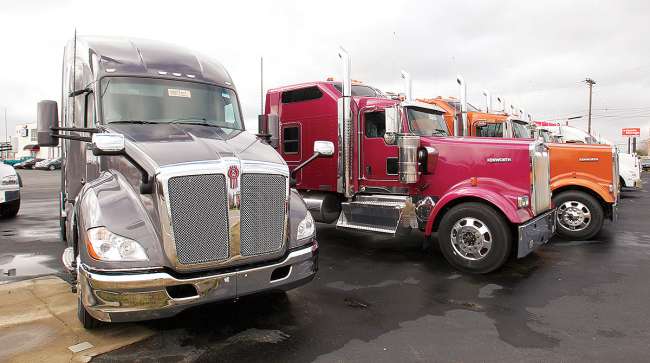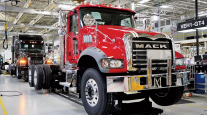Staff Reporter
Class 8 Orders in July Sink to Lowest Level Since 2010

[Stay on top of transportation news: Get TTNews in your inbox.]
Class 8 orders were down to their lowest level since 2010 in July, according to preliminary numbers from ACT Research.
North America Class 8 orders came to 10,200 units in July, down 21% from June. It was the lowest monthly order tally since February 2010, ACT reported.
“Weak freight market and rate conditions across North America and a still-large Class 8 backlog continue to bedevil new Class 8 orders,” said Kenny Vieth, ACT president and senior analyst, in a news release. “Though, with original equipment manufacturers opening their new model-year order books in June and July, order weakness is increasingly the story of an overcapacitized Class 8 fleet.”

Tam
Steve Tam, ACT Research vice president, told Transport Topics Aug. 5 that July tends to be the weakest month for orders, and usually runs 15% below normal months.
Still, the numbers indicate increasing uncertainty about President Donald Trump’s trade policies and the economy in general. On Aug. 5, China announced new strategies in the trade war, devaluing its currency and canceling U.S. agricultural imports, according to Bloomberg News.
“We have uncertainty in the market,” said Tam. “It’s not just tariffs.”
Tam said the uncertainty causes “analysis paralysis,” meaning trucking firms put off buying new trucks while they consider how the economy is going.
The research certainly suggests the trucking economy has cooled since the highs of 2018.
Another research firm, FTR of Bloomington, Ind., reported preliminary North American Class 8 orders for July were 9,800 units, falling below a 10,000-unit threshold that has not been breached since 2010, FTR officials said in a news release.
“Despite most order boards being opened for 2020 build slots, carriers appear in no rush to grab production capacity,” FTR officials said. “July orders were 24% below an already soft June with a negative 82% year-to-year comparison. Class 8 orders for the past 12 months have now fallen to a total of 288,000 units.”
FTR said fleets continue to take a wait-and-see approach to 2020 equipment.
“Potentially higher equipment costs, uncertain demand, and enough available capacity in the market are keeping order activity at bay,” said Jonathan Starks, FTR chief intelligence officer, in the news release.
But at least one firm has plans to replace 2,000 trucks. Celadon Group of Indianapolis said it plans to replace 2,000 tractors in the next several quarters.

Svindland
Paul Svindland, Celadon CEO, said with the company’s new infusion of $165 million of investment cash, the company can move on to the next round of improvements and begin to replace 2,000 four- and five-year-old tractors.
“Our fleet refresh is underway, with approximately 100 new trucks delivered since May, another 100 scheduled for August, and approximately 1,800 more expected to arrive over the next several quarters,” said Svindland in a July 29 news release. “These new trucks will dramatically lower our costs, enhance productivity, and improve the lives and safety of our professional drivers.”
Celadon ranks No. 38 on the Transport Topics Top 100 list of the largest for-hire carriers in North America.
Vieth said after a seven-year positive run, the medium-duty segment is looking increasingly tired, with July’s preliminary Classes 5-7 net orders at 15,900 units, down 20% year-over-year and 18% through year-to-date July.
ACT Research is based in Columbus, Ind.




